The automotive market is constantly evolving, with manufacturers pushing boundaries in technology, performance, and comfort. As two leading players, Mercedes-Benz and Volkswagen bring their flagship offerings to the table, the GLB and Tayron stand out in the growing SUV segment. In this comparative analysis, we’ll explore the technical aspects and innovations that define these vehicles.
Mercedes GLB vs VW Tayron – Which one offers the better deal?
Compare performance, boot capacity, efficiency and price at a glance.
Find out which car is the better choice for you – Mercedes GLB or VW Tayron?
Design and Dimensions
The Mercedes GLB packs a robust design that exudes luxury and sophistication. Measuring 4634mm in length, 1834mm in width, and 1692mm in height, its dimensions are compact enough for urban driving but roomy enough for family use. It boasts a practical trunk capacity of 565 to 570 liters, perfect for everyday errands or weekend trips.
In contrast, the Volkswagen Tayron is slightly larger, with a length of 4792mm and a width of 1853mm. Its height is comparable at 1668mm, allowing for an equally spacious cabin. With a trunk capacity ranging from 705 to 885 liters, it provides more luggage space, making the Tayron a preference for those who prioritize cargo capacity.
Powertrains and Performance
Mercedes-Benz offers the GLB with a variety of powertrains, including petrol and diesel options, along with a mild-hybrid engine. Power outputs range from 116 HP to a thrilling 320 HP, catering to different driving preferences. The GLB can accelerate from 0-100 km/h in as little as 5.5 seconds, showcasing its sporty capabilities. Fuel consumption varies between 5.6 to 9 L/100km, depending on the engine choice.
On the other hand, the VW Tayron features a range of powertrains that includes petrol, diesel, and a plug-in hybrid variant. It offers power outputs of up to 272 HP, with impressive acceleration capabilities - the quickest model can sprint from 0-100 km/h in just 7.3 seconds. Economically, the Tayron shines with a fuel consumption rating as low as 0.4 L/100 km in its hybrid variant, making it an eco-friendly choice for those who prioritise sustainability.
Transmission and Drive Systems
Both the GLB and Tayron are equipped with advanced automatic transmission systems, enhancing driving comfort. The GLB utilizes a dual-clutch automatic gearbox, providing quick gear shifts and responsiveness. It is available in front-wheel drive or all-wheel drive configurations, ensuring versatility for various driving conditions.
Similarly, the Tayron employs a dual-clutch automatic transmission, offering seamless transitions between gears. It, too, is available in both front and all-wheel drive options, appealing to those who seek performance and stability on varied terrains.
Technological Innovations
The Mercedes GLB is equipped with a state-of-the-art infotainment system that integrates Mercedes’ MBUX technology. This innovation includes voice command capabilities, allowing drivers to manage navigation and media with ease. Safety features are paramount, with comprehensive active safety systems that enhance driving confidence.
Conversely, the VW Tayron embraces modern connectivity and smart features, including a digital cockpit that provides vital information at a glance. Advanced driver assistance systems are incorporated, ensuring passengers are well-protected while on the road. The plug-in hybrid option of the Tayron allows drivers to navigate short distances using electric power alone, with an electric range of up to 126 km.
Conclusion
In summary, both the Mercedes GLB and VW Tayron cater to a discerning audience looking for practicality, performance, and innovative technology in an SUV. The GLB highlights a luxurious design and sporty engine range, while the Tayron excels with its larger cargo capacity and environmentally-friendly hybrid options. Ultimately, the choice between these two fantastic SUVs will come down to personal preference and specific lifestyle needs.
Here’s where it gets real: The technical differences in detail
Costs and Efficiency:
Price and efficiency are key factors when choosing a car – and this is often where the real differences emerge.
VW Tayron has a minimal advantage in terms of price – it starts at 39000 £, while the Mercedes GLB costs 40500 £. That’s a price difference of around 1531 £.
Fuel consumption also shows a difference: VW Tayron manages with 0.40 L and is therefore significantly more efficient than the Mercedes GLB with 5.60 L. The difference is about 5.20 L per 100 km.
Engine and Performance:
Power, torque and acceleration are the classic benchmarks for car enthusiasts – and here, some clear differences start to show.
When it comes to engine power, the Mercedes GLB has a somewhat edge – offering 320 HP compared to 272 HP. That’s roughly 48 HP more horsepower.
In acceleration from 0 to 100 km/h, the Mercedes GLB is to a small extent quicker – completing the sprint in 5.50 s, while the VW Tayron takes 6.10 s. That’s about 0.60 s faster.
In terms of top speed, the Mercedes GLB performs hardly perceptible better – reaching 250 km/h, while the VW Tayron tops out at 240 km/h. The difference is around 10 km/h.
Both models offer the same torque – 400 Nm.
Space and Everyday Use:
Beyond pure performance, interior space and usability matter most in daily life. This is where you see which car is more practical and versatile.
Both vehicles offer seating for 5 people.
In curb weight, Mercedes GLB is barely noticeable lighter – 1640 kg compared to 1682 kg. The difference is around 42 kg.
In terms of boot space, the VW Tayron offers distinct more room – 885 L compared to 570 L. That’s a difference of about 315 L.
In maximum load capacity, the VW Tayron performs a bit better – up to 2090 L, which is about 285 L more than the Mercedes GLB.
When it comes to payload, VW Tayron somewhat takes the win – 566 kg compared to 500 kg. That’s a difference of about 66 kg.
Who wins the race?
The VW Tayron proves to be dominates this comparison and therefore becomes our DriveDuel Champion!
VW Tayron is the better all-rounder in this comparison.
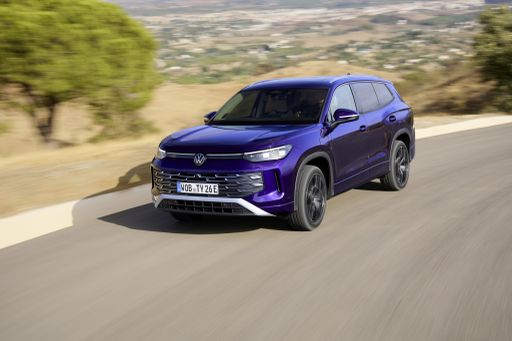 @ Volkswagen AG / VW Media
@ Volkswagen AG / VW Media
VW Tayron
Mercedes GLB
The Mercedes-Benz GLB exudes a robust yet sophisticated presence, combining the versatility of an SUV with the elegance the brand is renowned for. Its spacious interior is thoughtfully designed to accommodate modern lifestyles, offering flexibility and comfort for both drivers and passengers. With advanced technology seamlessly integrated throughout, the GLB ensures a driving experience that is both dynamic and intuitive.
details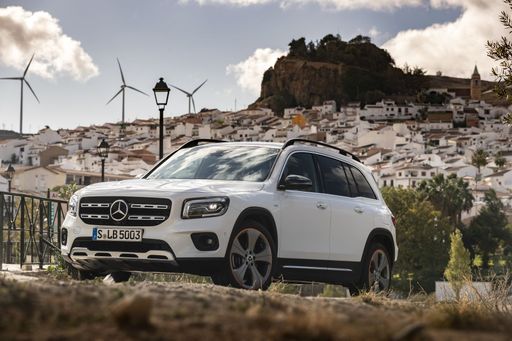 @ Mercedes-Benz Group Media
@ Mercedes-Benz Group Media
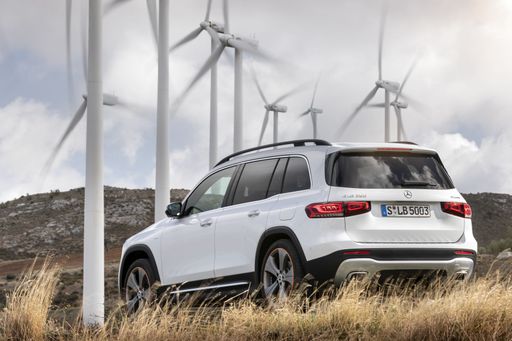 @ Mercedes-Benz Group Media
@ Mercedes-Benz Group Media
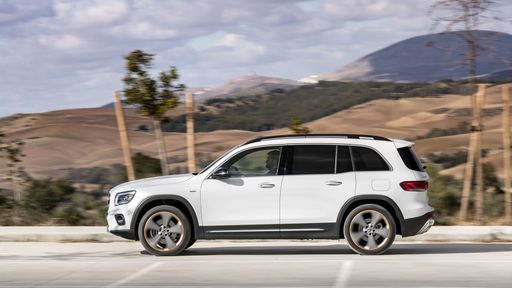 @ Mercedes-Benz Group Media
@ Mercedes-Benz Group Media
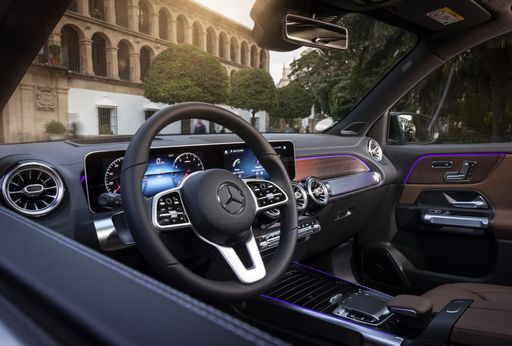 @ Mercedes-Benz Group Media
@ Mercedes-Benz Group Media
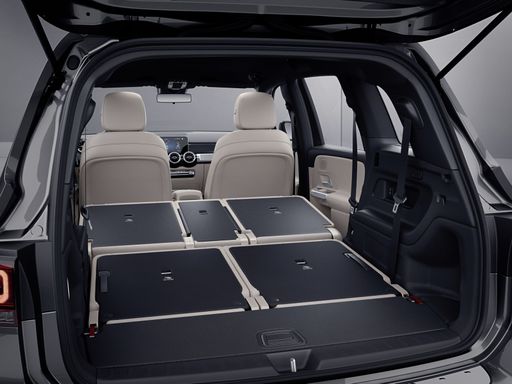 @ Mercedes-Benz Group Media
@ Mercedes-Benz Group Media
VW Tayron
The Tayron stands out as a stylish and versatile SUV that expertly blends form and function. With its spacious interior and modern design, it caters to families and adventure seekers alike, making every journey enjoyable. Equipped with advanced technology and safety features, the Tayron promises a driving experience that is both secure and exhilarating.
details @ Volkswagen AG / VW Media
@ Volkswagen AG / VW Media
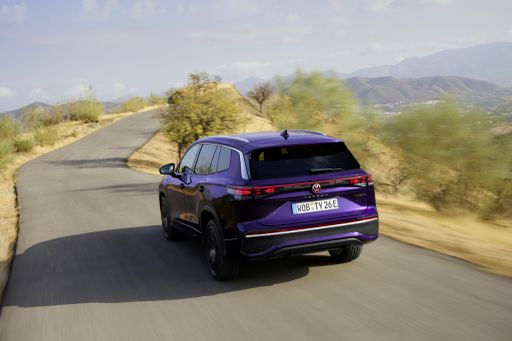 @ Volkswagen AG / VW Media
@ Volkswagen AG / VW Media
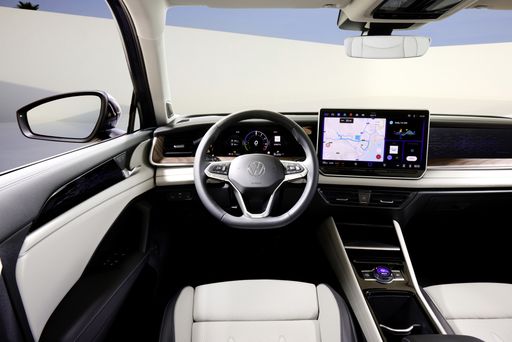 @ Volkswagen AG / VW Media
@ Volkswagen AG / VW Media
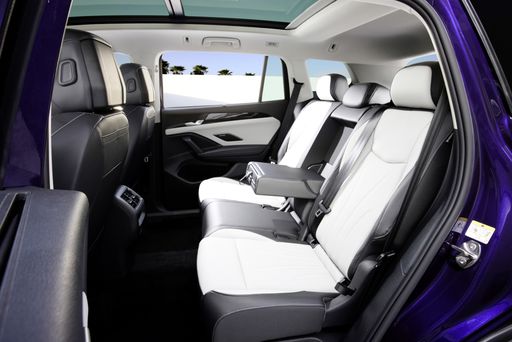 @ Volkswagen AG / VW Media
@ Volkswagen AG / VW Media
 @ Mercedes-Benz Group Media
@ Mercedes-Benz Group Media
|
 @ Volkswagen AG / VW Media
@ Volkswagen AG / VW Media
|
|
|
|
Costs and Consumption |
|
|---|---|
|
Price
40500 - 65300 £
|
Price
39000 - 52600 £
|
|
Consumption L/100km
5.6 - 9 L
|
Consumption L/100km
0.4 - 8.5 L
|
|
Consumption kWh/100km
-
|
Consumption kWh/100km
-
|
|
Electric Range
-
|
Electric Range
117 - 126 km
|
|
Battery Capacity
-
|
Battery Capacity
19.70 kWh
|
|
co2
146 - 204 g/km
|
co2
9 - 192 g/km
|
|
Fuel tank capacity
52 - 60 L
|
Fuel tank capacity
45 - 58 L
|
Dimensions and Body |
|
|---|---|
|
Body Type
SUV
|
Body Type
SUV
|
|
Seats
5
|
Seats
5
|
|
Doors
5
|
Doors
5
|
|
Curb weight
1640 - 1820 kg
|
Curb weight
1682 - 1948 kg
|
|
Trunk capacity
565 - 570 L
|
Trunk capacity
705 - 885 L
|
|
Length
4634 - 4650 mm
|
Length
4792 mm
|
|
Width
1834 - 1850 mm
|
Width
1853 - 1866 mm
|
|
Height
1665 - 1692 mm
|
Height
1666 - 1668 mm
|
|
Max trunk capacity
1800 - 1805 L
|
Max trunk capacity
1915 - 2090 L
|
|
Payload
500 kg
|
Payload
489 - 566 kg
|
Engine and Performance |
|
|---|---|
|
Engine Type
Petrol MHEV, Diesel
|
Engine Type
Petrol MHEV, Plugin Hybrid, Diesel, Petrol
|
|
Transmission
Automatic
|
Transmission
Automatic
|
|
Transmission Detail
Dual-Clutch Automatic
|
Transmission Detail
Dual-Clutch Automatic
|
|
Drive Type
Front-Wheel Drive, All-Wheel Drive
|
Drive Type
Front-Wheel Drive, All-Wheel Drive
|
|
Power HP
116 - 320 HP
|
Power HP
150 - 272 HP
|
|
Acceleration 0-100km/h
5.5 - 11.5 s
|
Acceleration 0-100km/h
6.1 - 9.7 s
|
|
Max Speed
188 - 250 km/h
|
Max Speed
204 - 240 km/h
|
|
Torque
230 - 400 Nm
|
Torque
250 - 400 Nm
|
|
Number of Cylinders
4
|
Number of Cylinders
4
|
|
Power kW
85 - 235 kW
|
Power kW
110 - 200 kW
|
|
Engine capacity
1332 - 1991 cm3
|
Engine capacity
1498 - 1984 cm3
|
General |
|
|---|---|
|
Model Year
2025
|
Model Year
2025
|
|
CO2 Efficiency Class
E, F, G
|
CO2 Efficiency Class
E, B, F, G
|
|
Brand
Mercedes-Benz
|
Brand
VW
|
What drivetrain options does the Mercedes GLB have?
Available configurations include Front-Wheel Drive or All-Wheel Drive.
The prices and data displayed are estimates based on German list prices and may vary by country. This information is not legally binding.
